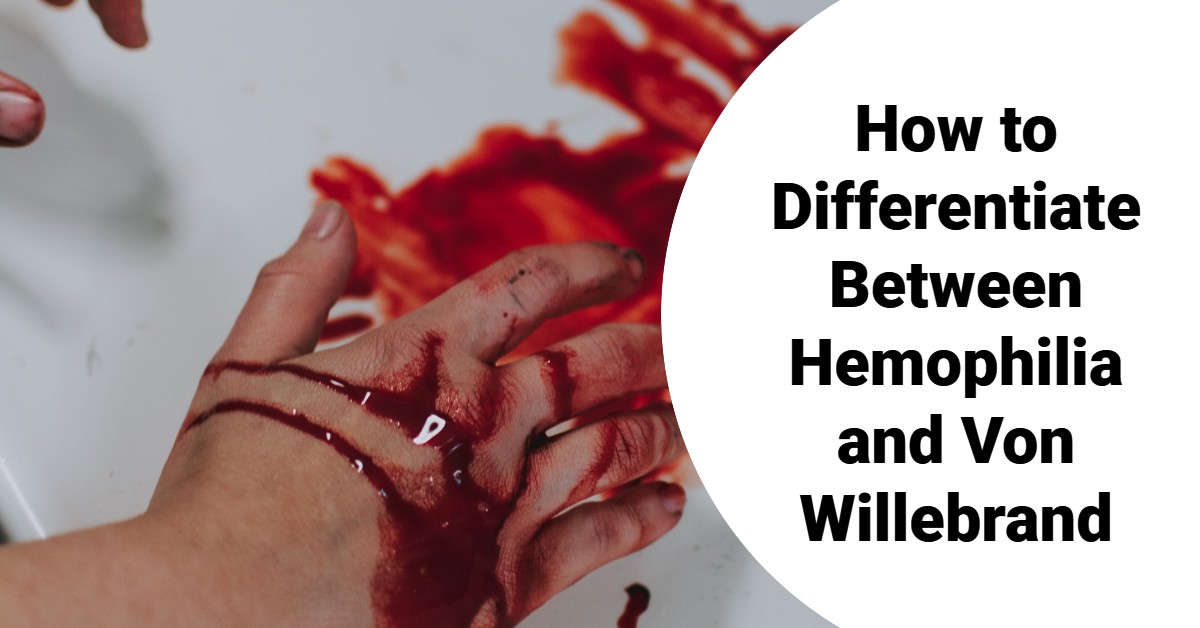How to Differentiate Between Hemophilia and Von Willebrand

How to Differentiate Between Hemophilia and Von Willebrand: When it comes to bleeding disorders, it’s important to understand the differences between various conditions to provide accurate diagnosis and appropriate treatment.

Hemophilia and von Willebrand disease are two of the most common bleeding disorders, but they have distinct differences that can sometimes be difficult to discern. While both conditions can result in prolonged bleeding after injury, they are caused by different underlying factors and require different treatment approaches.
In this article, we’ll explore the key differences between hemophilia and von willebrand disease to help you better understand these two conditions and how to differentiate between them.
How to Differentiate Between Hemophilia and Von Willebrand (FAQs & Answers)
Are Hemophilia and Von Willebrand disease the same disorder?
No, Hemophilia and Von Willebrand disease are two different genetic bleeding disorders with different underlying causes, inheritance patterns, and bleeding symptoms.
Can both males and females be affected by Hemophilia and Von Willebrand disease?
Hemophilia mainly affects males, while Von Willebrand disease can affect both males and females.
Is genetic testing used to diagnose Hemophilia and Von Willebrand disease?
Yes, genetic testing may be used to confirm a diagnosis of Hemophilia or Von Willebrand disease.
What is Von Willebrand Disease?
Von Willebrand disease (VWD) is a genetic bleeding disorder caused by a deficiency or dysfunction of von Willebrand factor (VWF), a protein that helps the blood clot. VWF is important for platelet function and stabilization, as well as carrying and protecting clotting factor VIII in the bloodstream. Without enough VWF, bleeding can be prolonged and excessive, particularly in mucous membranes, such as the nose and mouth, and in response to minor injuries. There are three types of VWD, each with different levels of severity and patterns of bleeding symptoms. While VWD is less severe than hemophilia, it can still cause significant problems and requires appropriate management to prevent complications.
Types of Von Willebrand Disease
Type 1:
This is the mildest and most common form of VWD, accounting for about 70% of all cases. People with type 1 VWD have lower than normal levels of von Willebrand factor, but it is usually sufficient to prevent major bleeding episodes.
Type 2:
This type is divided into four subtypes (2A, 2B, 2M, and 2N), each with its own unique characteristics. In type 2 VWD, there is a qualitative deficiency in the von Willebrand factor, meaning that the factor is present but does not function properly. People with type 2 VWD may experience more bleeding episodes than those with type 1.
Type 3:
This is the rarest and most severe form of VWD, accounting for less than 5% of all cases. People with type 3 VWD have virtually no von Willebrand factor, which can lead to frequent and prolonged bleeding episodes, particularly in the joints and muscles.
Signs and symptoms of Von Willebrand Disease
- Frequent or prolonged nosebleeds
- Easy bruising or bleeding after minor injuries
- Heavy or prolonged menstrual bleeding
- Bleeding gums or mouth sores
- Excessive bleeding after dental procedures or surgery
- Joint pain or swelling caused by internal bleeding
- Blood in urine or stool
- Skin that bruises easily
- Anemia due to chronic blood loss
It’s important to note that these symptoms can also be caused by other conditions, so a proper diagnosis by a medical professional is necessary to determine if VWD is the cause of the symptoms. Additionally, the severity and frequency of bleeding episodes can vary widely among people with VWD, so it’s important for individuals with VWD to work closely with their healthcare provider to develop an appropriate treatment plan.
Treatment
The course of treatment is similar to that for moderate hemophilia, albeit clinical conditions may need adjustments. Desmopressin is typically administered whenever there is a chance. Sometimes the patient receives an injection of factor VIII concentrate made from plasma.
What is Hemophilia?
Hematological disorder hemophilia is almost exclusively found in males.
This condition is known as classic hemophilia or hemophilia A when it results from a shortage of clotting factor VIII, which accounts for the majority of cases. Hemophilia B, the other less common kind of hemophilia, is brought on by a lack of the clotting factor IX.
Both of these traits are inherited via the female chromosomes. As a result, the likelihood of a female developing hemophilia is exceedingly low because it is rare that both of her chromosomes will change at the same time. The term “hemophilia carriers” refers to females with a single defective chromosome.
Types of Hemophilia
There are three main types of hemophilia: hemophilia A and hemophilia B.
Hemophilia A
Hemophilia A is the most common type and is caused by a deficiency in clotting factor VIII. Without enough factor VIII, the blood is unable to clot properly, leading to prolonged and excessive bleeding. This type of hemophilia (Hemophilia A) is also known as classic hemophilia.
Hemophilia B
Hemophilia B, also known as Christmas disease, is caused by a deficiency in clotting factor IX. People with hemophilia B may experience similar symptoms to those with hemophilia A, including excessive bleeding and joint pain and swelling.
Hemophilia C
There is also a rare form of hemophilia known as hemophilia C, which is caused by a deficiency in clotting factor XI. Hemophilia C is typically less severe than hemophilia A or B and is more common in certain populations, including people of Ashkenazi Jewish descent.
It’s important to note that the severity of hemophilia can vary depending on the level of clotting and factor deficiency. And that even individuals with the same type and level of hemophilia can experience different symptoms and severity of bleeding episodes.
Treatment
To restore their levels, factor VIII or factor IX is supplied intravenously.
Factor VIII has a 12-hour half-life. As a result, it needs to be given at least twice daily to maintain the right levels. However, because factor IX has a longer half-life of 18 hours, it is adequate to inject it once each week.
How to Differentiate Between Hemophilia and Von Willebrand (Key point)
Hemophilia and Von Willebrand disease are both genetic bleeding disorders, but they differ in their underlying causes and the specific bleeding symptoms that they cause. Here are some key points to differentiate between Hemophilia and Von Willebrand disease:
Cause:
Hemophilia is caused by a deficiency of clotting factor VIII (hemophilia A) or clotting factor IX (hemophilia B), while Von Willebrand disease is caused by a deficiency or dysfunction of Von Willebrand factor (VWF).
Inheritance:
Hemophilia is an X-linked recessive disorder, meaning that it mainly affects males and is passed down through the maternal line. Von Willebrand disease is inherited in an autosomal dominant pattern, meaning that both males and females can be affected, and the disease can be passed down through either parent.
Severity:
Hemophilia is usually more severe than Von Willebrand disease, with bleeding symptoms ranging from spontaneous bleeding into joints and muscles to life-threatening bleeding episodes. Von Willebrand disease can cause bleeding symptoms that are similar to Hemophilia, but they are typically less severe.
Bleeding Symptoms:
Hemophilia can cause bleeding symptoms such as joint pain and swelling, easy bruising, and prolonged bleeding after injury or surgery. Von Willebrand disease can cause these same symptoms, but it can also cause other bleeding symptoms such as nosebleeds, heavy menstrual periods, and bleeding from the gums.
Diagnosis:
Hemophilia and Von Willebrand disease are both diagnosed through blood tests that measure clotting factor levels and Von Willebrand factor activity. However, the specific tests used may differ depending on the suspected disorder. Genetic testing may also be used to confirm a diagnosis.
Conclusion
Hemophilia and Von Willebrand disease are two uncommon hematological disorders that are frequently brought on by a lack of different elements necessary for the coagulation process. The main distinction between hemophilia and von Willebrand disease is that hemophilia is characterized by either a factor VIII or factor IX deficit, whereas von Willebrand disease is characterized by a lack of the von Willebrand factor.
Recommended:
How To Stop Bleeding (2023 Home Remedies)
How To Stop Bleeding (Steps and Requirements)




